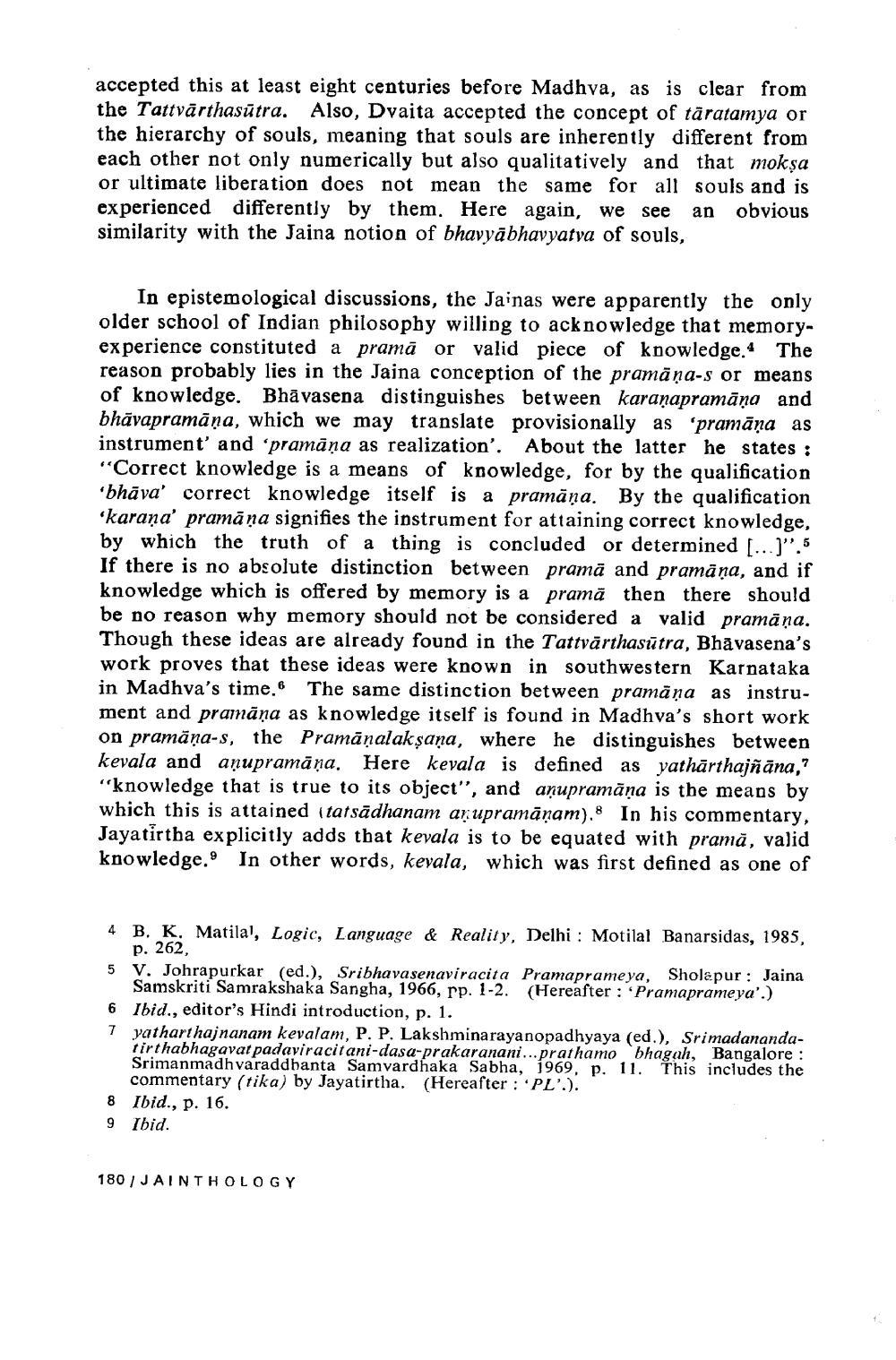________________
accepted this at least eight centuries before Madhva, as is clear from the Tattvārthasūtra. Also, Dvaita accepted the concept of tāratamya or the hierarchy of souls, meaning that souls are inherently different from each other not only numerically but also qualitatively and that mokşa or ultimate liberation does not mean the same for all souls and is experienced differently by them. Here again, we see an obvious similarity with the Jaina notion of bhavyabhavyatya of souls,
In epistemological discussions, the Jainas were apparently the only older school of Indian philosophy willing to acknowledge that memoryexperience constituted a pramā or valid piece of knowledge. The reason probably lies in the Jaina conception of the pramāņa-s or means of knowledge. Bhāvasena distinguishes between karanapramāna and bhāvapramāņa, which we may translate provisionally as 'pramāņa as instrument' and 'pramāna as realization'. About the latter he states : "Correct knowledge is a means of knowledge, for by the qualification bhāva' correct knowledge itself is a pramāņa. By the qualification ‘karana' pramāņa signifies the instrument for attaining correct knowledge, by which the truth of a thing is concluded or determined [...]”.5 If there is no absolute distinction between pramā and pramāņa, and if knowledge which is offered by memory is a pramā then there should be no reason why memory should not be considered a valid pramāņa. Though these ideas are already found in the Tattvārthasūtra, Bhavasena's work proves that these ideas were known in southwestern Karnataka in Madhva's time. The same distinction between pramāņa as instrument and pramāņa as knowledge itself is found in Madhva's short work on pramāņa-s, the Pramāņalak saņa, where he distinguishes between kevala and aņupramāņa. Here kevala is defined as yathārthajñāna,? "knowledge that is true to its object", and aņupramāņa is the means by which this is attained (tatsādhanam ar upramāņam).8 In his commentary, Jayatirtha explicitly adds that kevala is to be equated with pramă, valid knowledge.9 In other words, kevala, which was first defined as one of
4
B. K. Matilal, Logic, Language & Reality, Delhi : Motilal Banarsidas, 1985, p. 262,
5 V. Johrapurkar (ed.), Sribhavasenaviracita Pramaprameya, Sholapur: Jaina
Samskriti Samrakshaka Sangha, 1966, rp. 1-2. (Hereafter : 'Pramaprameya'.) 6 Ibid., editor's Hindi introduction, p. 1. 7 yatharthajnanam kevalam, P. P. Lakshminarayanopadhyaya (ed.), Srimadananda
tirthabhagavat padaviracitani-dasa-prakaranani...prathamo bhagah, Bangalore : Srimanmadhvaraddhanta Samvardhaka Sabha, 1969, p. 11. This includes the
commentary (tika) by Jayatirtha. (Hereafter : PL'.). 8 Ibid., p. 16. 9 Ibid.
180 / JAINTHOLOGY




